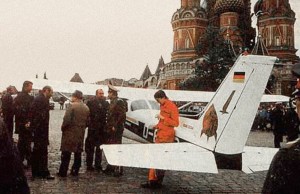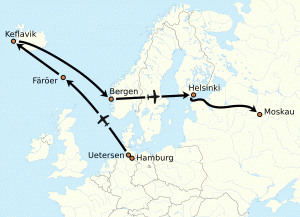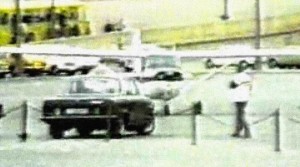Published on May 28, 2013
The year was 1987. Mathias Rust was just 19 years old. He was a private pilot from Germany with 50 hours of total flight time, newly certified and completely inexperienced. His aircraft was a typical Cessna design, a Reims Cessna F172P — the registration code was D-ECJB (D designating West Germany). Yet he was inspired. In the waning days of the Cold War, he imagined that through his own personal action, by flying from Western Europe to Moscow, he could help end the Cold War. Naively, Rust flew his Cessna right through the heart of the Soviet Union’s air defense networks and, improbably, landed right next to Red Square. That he survived was a miracle, though he didn’t realize it at the time. Everyone laughed at the seeming insanity of his flight. After all, how could one private citizen, with just one flight in a Cessna help end the Cold War?
Except that they were all wrong. It worked. Mathias Rust changed history and his flight really did help end the Cold War.

The Dream and Rust’s Planning
When Mathias Rust took off from Germany, he already knew what he had to do. As Rust noted, “I said to myself, something need[s] to be done to improve the situation — and then I came up with this idea to use the aircraft to build an imaginary bridge between West and East.” Yet he wasn’t aiming to fly straight to Moscow. First, he needed to hone his pilot skills. After all, he had just 50 hours and was newly certificated. Could he reasonably even navigate himself and his plane to Moscow?
With that in mind, on May 13, he flew first to the Faeroe Islands and then onward to Keflavik, Iceland. Incredibly, he was so inexperienced that his “practice flight” involved flying halfway across the Atlantic Ocean in a single engine Cessna, without maritime survival gear or any serious over water preparations. He essentially had retraced half of Charles Lindbergh’s famous flight in the Spirit of St. Louis, except backwards. Luckily, his engine didn’t quit. With that, he felt he had gained the necessary confidence to fly to Moscow.
To bolster his spirit before departing back eastward, he visited Iceland’s Hofdi House, the site of the previous negotiations from eight months before in October 1986 between Ronald Reagan, the American President and the Soviet Union’s leader, Mikhail Gorbachev. Those talks had ended badly, despite high hopes on both sides. The key problem was that Soviet hardliners were preventing Gorbachev from softening the country’s militaristic outlook so that mutual arms reductions could follow. Seeing Hofdi House, however, Rust was sure then that he could make a difference, even where the combined leadership of both countries had failed.
From Iceland, Mathias Rust flew to Helsinki, Finland, via Bergen, Norway. After a brief rest, he was ready for his flight to Moscow. On May 28, 1987 — today in aviation history — he took off, hoping to navigate successfully to Moscow. As for planning, he approached the flight as if Moscow was just another destination on the map. He didn’t consider tactics or methods to avoid detection, nor how to evade interception. He didn’t ponder how his Cessna might keep from being blasted out of the sky by anti-aircraft guns, nor how he might avoid getting hit by a surface to air missile. The only thing he did to camouflage his intent was to file a fake flight plan for Stockholm, Sweden.

Rust’s Flight into History
Soon after Mathias Rust took off, he turned off the radios, did a 180 degree turn away from his filed destination of Sweden and flew east toward the Soviet Union. Ahead was the world’s most formidable air defense system, against which he was in an unarmed Cessna with no electronic equipment, no jamming, no stealth technologies nor any special systems. It was Mathias Rust alone facing down the Great Soviet Bear — one man against the world’s second largest military power. He knew the risk — at best, he judged, he had a 50-50 shot of making it to Moscow. The Soviets were well experienced in detecting incoming threats and they typically reacted with extreme violence. Even civilian jetliners, like Korean Airlines flight KAL 007, had been shot down without mercy.
As he exited Finnish airspace heading across the Baltic, the Finns saw him drop off their radar. His transponder was switched off and their calls over the radio went unanswered. The Finnish air traffic controllers concluded that he must have crashed. Reacting quickly, a full scale search and rescue effort was mounted. (Later, the authorities demanded that Rust pay $100,000 to help cover the costs of that effort.) He hadn’t crashed, however, and was soon entering Soviet-ruled airspace off the coast of Estonia, where he was picked up by a radar controller, who designated him as a hostile target and requested an interception — all force was to be used, as necessary, to engage and destroy the approaching aircraft.
A pair of Soviet fighters were launched to intercept him. Making a pass nearby, the Soviet pilots recognized his plane as civilian. They asked permission to shoot Rust down. As Rust later told a Danish TV interviewer, relating how he felt when he spotted the Soviet fighters:
“And I was very scared, and very shocked. It was like my heart fell own on my pants […] and I was asking myself very intensively, ‘What is going to happen next? What are they going to do? They going to stop me now, they just shoot at me?’ It was really awful and it was such a relief when I noticed that after 2, 3 minutes, after they passed me, they just disappeared.”
Rust crossed the border as if it wasn’t there. Continuing on, he took no precautions once inside the Soviet Union. He flew along at a typical flight training, cross country altitude, throttled back to a normal cruise speed. His bright white Cessna was easy to spot. What was on his side, however, was that his plane wasn’t military at all — quite obviously so. Strangely, the few Soviet pilots and ground observers who spotted him thought they had spotted a Soviet type called a Yak 12, one of the many East Bloc training planes in service at that time. Maybe he was off course, they reasoned, and let him pass.
Continuing Lucky Coincidences
Next, he flew over the junction of two airspace regions where the radar controllers on both sides had been recently assigned monitoring duty for both adjacent districts — for lack of time given the increase in workload, they assumed all flights entering and leaving were friendly, which was a reasonable conclusion since any aircraft there would have had to already penetrate the Soviet border defenses to get there in the first place. Thereafter, he blundered through a district that was undertaking military exercises. Incredibly, since so many inexperienced Soviet military pilots participating in the exercise had misdialed their IFF codes or failed to turn on their IFF system, the ground controllers had started ignoring IFF signal warnings that would have identified him as an intruder. Once again, he flew past safely.

Arriving in Moscow
Flying closer to Moscow, he might well have been shot down yet again but for another strange coincidence. The day before Rust’s flight, a Soviet aircraft had crashed and intensive search and rescue operations were underway. As a result, air traffic volume was at an extremely high point as rescue helicopters shuttled to and from the crash site. Rust’s Cessna, due to its slow speed and low altitude, was mistaken by ground controllers as being another helicopter participating in the crash site rescue operations. Once again, he flew past unscathed.
No less than four coincidences and bizarre mistakes had come together and unexpectedly allowed him to fly untouched, unidentified and unscathed all the way to Moscow. Mathias Rust wasn’t just lucky, it was as if he was on some sort of divinely blessed mission of peace, as if the curtains of the heaviest air defenses in the world were pulled apart briefly to allow him to pass.
Once over Moscow, however, he realized that it was far more difficult to find Red Square. In a city of over 12 million, his destination is a small point amidst a large urban area, much of it nondescript Stalinist buildings, often identical to one another. He flew around over the city at low altitude for a half hour — incredibly, he was never intercepted, challenged or shot at during that entire time.

Arrival over Red Square
Finally locating his destination, Rust slowly circled St. Basil’s Cathedral, Red Square and the Kremlin. Originally, he had thought he might land within the walls of the Kremlin itself but upon seeing the imposing walls, he realized that he would be simply arrested and have his plane seized. With that, he might just “disappear” — probably forever. Rust intuitively recognized that the KGB and the Soviet leadership would deny that he had ever arrived. He realized then that he had to make a more public arrival and thus, he decided to land in Red Square itself.
That too, however, proved impossible. Red Square was packed with civilians. There was no place to land at all, unless he was willing to risk running someone over with his plane and propeller. To do that would not send the message of peace he had so dearly desired. He circled again and found a nearby bridge that was largely empty of traffic — straight and true, it would serve as a reasonable landing strip and, what was even better, he could taxi off the end of the bridge right up to the edge of Red Square. He executed a near perfect landing and taxied to Red Square. Luck again played a part — communications wires that were usually in place atop the bridge had been removed for maintenance the day before his landing; they were scheduled to be replaced the day after. He had landed on the one day that the bridge was clear of obstacles.
Once at Red Square, instead of being instantly arrested, Mathias Rust was met informally by many interested Soviet citizens. Soon, he was signing autographs and telling people about his flight and mission of peace. It took nearly two hours for Soviet authorities to come and arrest him — it was the final screw-up on the part of the Soviets that allowed him to achieve success. As Rust later recalled, “”I felt myself so light, so easy because it was just an unbelievable dream came true.”

Aftermath
Mathias Rust’s flight to Moscow was unexpected, unplanned and unbelievable. For Soviet citizens, it was the final straw. Public respect for the Soviet military was shattered. If the country’s vaunted military forces couldn’t even stop a Cessna, they were a joke. Rust’s flight had contributed to the loss of faith in the government that was slowly spreading, much of it due to Soviet economic policy failures and the spiraling war in Afghanistan, which many considered to be the Soviet Union’s Vietnam debacle. For Gorbachev too, Mathias Rust’s flight proved to be a much needed, highly beneficial event. It allowed Gorbachev to uproot and “retire” numerous senior military leaders and hardliners for their failures in not intercepting Rust and his Cessna. In this way, it cleared the way for more balanced negotiations with the West on arms reduction, stabilization and the end of the Cold War.
Thus, against all odds, a naive, 19 year old, newly minted private pilot that everyone thought was crazy had achieved the impossible. Mathias Rust’s dream that he could help end the Cold War had become an undeniable reality. It didn’t all happen as he thought it would, but the ends were exactly as he had seen in his dreams.
As Rust summed it up 20 years after the event for Danish TV, “I felt myself so light, so easy because it was just an unbelievable dream came true.” Indeed, a peaceful end of the Cold War was everyone’s dream. That Mathias Rust could have had such an impact is astonishing, but also somehow fitting. One person can truly make a difference. Just a few years later, the West would watch in awe as the flag went down on the Soviet Union.

Thank you very much for this write up! I remember this happening when I lived in the Netherlands in the late 80s. Back then he got incredibly negative press, and the general consensus was that he was spoilt and crazy. Very nice to see the truth and bigger picture put into print.